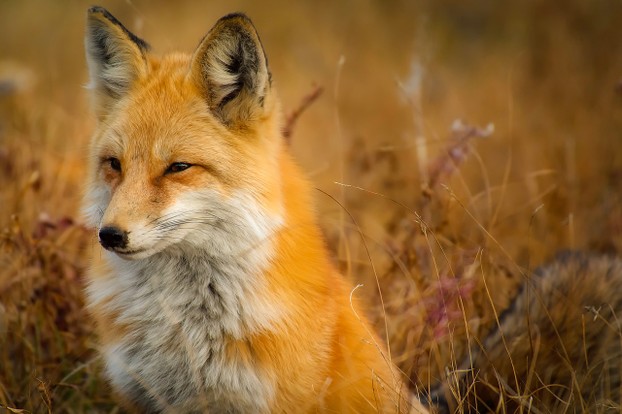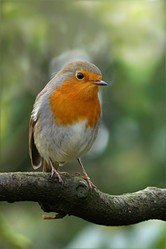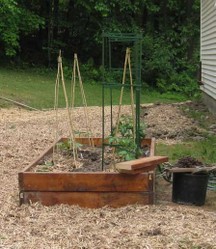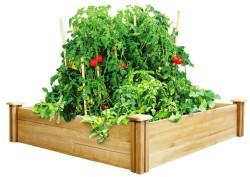I have not been shutting my greenhouse door recently,the weather is so warm that I do not need to, but the real reason is that an enterprising spider spins her webs across the top of the doorway. I have had fragments of her silk in my hair several times. I think that it is a garden spider, which is very common. Recently I was privileged to spot some new-born garden spiders, this time not in the greenhouse, but swarming on a web attached to a raised bed. The neonate arachnids were golden in the sunlight, and it was a delightful experience for me and some fellow gardeners whom I called over to see the creatures. They have spread far and wide now.
Finding nests is not always fun, as a year or ago I disturbed a wasps' nest and was stung four times for my endeavours. Precautionary medical advice was needed, but not all nests are dangerous. One year when weeding I found that ants were crawling over my hand. Puzzled, I noticed that it seemed to happen when I was working near to the wooden side of a bed. Lifting it up [it was not fixed, but merely a mobile divider, I uncovered a network of chambers and tunnels swarming with ants. I replaced the wood and let them be, for there is space on this earth for both them and me. But nests must be yearly replaced, and this year it is empty.
Bees are regular visitors. We now have honey bees,courtesy of a Syrian refugee who has introduced hives to his plot. The bees feast on the purple flowers of my Welsh onions, perennial onions related to chives, which are nectar rich. I leave the flowers for them intentionally, and they respond gratefully. As do the red mason bees and the various bumble bees. Red mason bees are superb pollinators and they do not sting. Solitary bees, they build cells in soil and venture forth for pollen. So as great pollinator they are welcome guests on my plot.Once I found that bumble bees were nesting under a pile of old pallets,and in response and part-payment for their pollinating services I left the pile in situ, but next year they did not return. I know not why.
We do not get a rich variety of butterflies,mainly cabbage whites.But to welcome butterflies I have a patch of nettles at the far edge of my plot. They serve partly to deter unwanted visitors from climbing the fence, but the nettles are a great butterfly food.
There are visiting insects. Shortly after I filled my pond I had a visit from a water boatman, an insect whose broad pads on its feet allow it to walk on water, taking advantage of he surface tension to support its weight. It must have blown in from somewhere, I know not whence it came and whither it went, for I saw it but once.
But some insects are regulars, such as the ladybirds, beasts popular for their beauty, but fierce predators of aphids, the greenflies that damage fruit plants. As a keeper of fruit trees ladybirds are great favourites of mine.
You would need to be an entomologist to account for all the insects and other mini-beasts that either dwell on allotment sites or visit on occasion, and I am no expert entomologist, so a brief account of the most common ones will suffice. We need to enjoy experiences in their totality, so while I value producing food, the experience of cultivation allows me to encounter nature and relish it, not only in the visual experience, but the auditory side, the songs of birds and the sighing of the wind.








 The North Wales Pilgrim Path28 days ago
The North Wales Pilgrim Path28 days ago
 Rewilding the Isle of the Thundergodon 02/17/2024
Rewilding the Isle of the Thundergodon 02/17/2024
 Adrienne von Speyr a life on the edge of heavenon 01/24/2024
Adrienne von Speyr a life on the edge of heavenon 01/24/2024
 The Granite Kingdom: a Cornish Journeyon 12/29/2023
The Granite Kingdom: a Cornish Journeyon 12/29/2023



Comments
British ants are harmless, though some people are annoyed by their presence. I am not annoyed, as I don't regard the world as being there just for me. Our ants do not destroy wooden structures or sting. Strangely, though, on the South Coast, Britain had a colony of termites, which destroyed a wooden holiday shack. The South Coast is the place for intruders/visitors from warmer climes, but they find it hard to spread north from there. We get occasional birds from warmer countries there.
I don't know much about ants, but we have fire ants here, and believe me, you would be very happy for those to go away permanently! Are yours nice ants that don't sting or destroy wood structures?
Something has puzzled me. The ants deserted their nest spot for two years, but on checking yesterday I discovered that they have returned. I cannot explain the pattern of their behaviour.
I spotted an insect that I have never seen before, a black and yellow longhorn beetle, which I observed in the area near the pond, which I keep wild. I am wondering whether Storm Desmond, which struck day or so ago [and did one of my plots some damage] has blown this beetle in.
There is a sign that says public footpath. They are marked on maps. There are also permissive paths, which are open due to the goodwill of a landowner. A bridleway is a path on which horses maybe ridden. There are also, mainly in the south, green lanes. These are ancient roads with an earth surface, which are not an active part of the public road network and which are mainly for walking and riding, though many are overgrown. Some disused railway lines have been turned into foot paths and cycleways. These have been very successful.
I have to say, though, that the paths vary in their quality and state of maintenance. One problem is motor cyclists using paths which are only suitable for walkers and churning them up.All of these paths are designated rights of way, which is a legal term.
That is interesting. I certainly would love to walk some of the footpaths I've seen mentioned.
In the United Kingdom we have a network of public footpaths that go through private property such as farm land, which count as roads, and anyone is free to walk on them, but that does not stop some landowners from obstructing them.The local authorities are responsible for keeping them open,but some local authorities are in league with the local landowners,so they don't do much to help. There is a footpath society that comes along and unblocks paths. In recent years the rules have been changed to widen access to allow non-destructive passage for walkers. In Scotland there has been a long tradition of public access to land.
Farmers can be prosecuted for allowing a dangerous bull to be free on land with a public footpath. Deliberately obstructing a footpath is a crime, though not many are prosecuted for it.
My account of the rules is a simplification of a complex set of laws.
Ha ha... yes the things we are capable of at 18! So you are allowed to walk through land that belongs to someone where cows are grazing?
The only really dangerous animals of which we must be wary are wild boar, which were kept behind steel fences in farms until some lunatic animal rights activists freed them. Others escaped after a serious storm. So far no human has been harmed by these creatures, though some dogs have come off worse in an encounter. But there are none near where I live and they prefer to avoid humans. But they have sharp teeth and tusks and the males can reach 350 pounds in weight. One fool of a journalist spoke of getting the shotgun to deal with them when they raid gardens. Crazy. A shotgun only stings them and gets them mad. It is either a high powered rifle or a hasty escape.
It is considered risky to walk through herds of cows, as some walkers have been trampled,occasionally fatally. A farmer told me that dairy bulls are the dangerous ones, but trampling by cows is more common than bull attacks. Once when I was eighteen [nearly fifty years ago] I was charged by a cow in a walk in the Chiltern hills in southern England. I vaulted a gate mighty fast! One foot on the lower rungs, then over! But you can do that at eighteen.
I had no idea hedgehogs were nocturnal. Since this page is about wildlife, I'm wondering if there is anything you are wary of when you take walks / hikes? In New Hampshire bear and moose (although I never saw a moose, just the tracks) and even the deer (they can be big and would stand and stare at me!) gave me pause when hiking / walking. Also skunks - being sprayed must be one of the worst things.